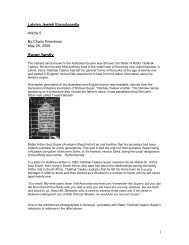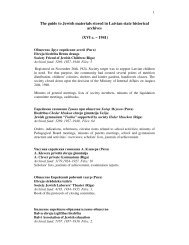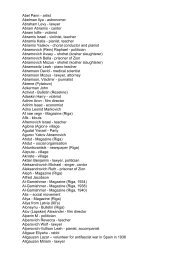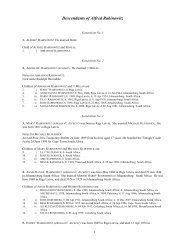Small Riga Ghetto
Small Riga Ghetto
Small Riga Ghetto
Create successful ePaper yourself
Turn your PDF publications into a flip-book with our unique Google optimized e-Paper software.
149<br />
through the destruction of the largest Jewish centers. Perhaps this will be the<br />
most tragic part of Jewish history after the churbn (destruction) of the Second<br />
Temple. It is possible that the number of victims will be so great that for a<br />
long time we will not be able to think clearly. Nonetheless we should avoid<br />
panic. A historian who studies the pages of Jewish history will realize the following:<br />
the deepest meaning of our history is hope, which becomes a reality<br />
again and again, for tyrants will always drown in their own blood. I am convinced<br />
that Germany will be destroyed, just as sure as I am of the fact that<br />
snow melts in the spring. Perhaps the Jewish kibbutzim (communities) in<br />
Europe will be destroyed for years, but we still have a powerful Jewish community<br />
in the United States of America, in Latin America and in the other<br />
English-speaking countries. Palestine may go through a great crisis in the coming<br />
years, but I hope that the jischuw (settlement) there will grow and flourish.<br />
We definitely need Palestine for our continued existence; even the non-Zionists<br />
need it. In the English-speaking countries we have to become proficient in the<br />
English language, but we should not neglect Yiddish. American Jewry will<br />
have to grow spiritually and understand the great task that fate has bestowed<br />
upon it."<br />
Today, seven years later, we clearly realize the truth of his prophetic words.<br />
The Germans occupied <strong>Riga</strong> and began, together with the Latvians, to destroy<br />
the Latvian Jewish community. The old professor was hidden as well as<br />
possible, but the Gestapo heard of his existence and he was arrested shortly<br />
before the opening of the ghetto in September 1941.<br />
His age and his imposing apperance did not prevent the murderers from<br />
beating him. They were interested in the manuscripts he had written in <strong>Riga</strong><br />
and demanded that he hand them over. But he had hidden these manuscripts,<br />
and he said he had left them in Kaiserwald, which he had left months before.<br />
He was released, but arrested again later. Thanks to the head of the Jewish<br />
Council, the Vienna Jew Schlitter, he was released again and this time was put<br />
into the ghetto, now a broken man. For this, Schlitter was arrested by the Gestapo<br />
and later killed.<br />
In the ghetto the old professor received a small room in the shelter on<br />
Ludzas Street. But even there he was not idle; he started to write an article<br />
about the ghetto, using the same mechanical pencil that he said had served him<br />
for thirty-seven years. During the days he spent in the ghetto – days that were<br />
already counted – he once again created a small Jewish intellectual center. In<br />
the first action, on 30 November 1941, he was transported to a second shelter<br />
on Blech Square, and later in the second action, on 8 December 1941, he was










